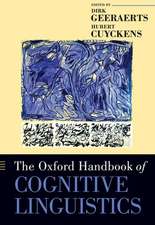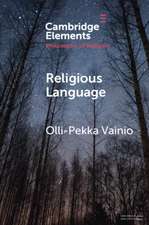Cognitive Linguistics and Religious Language: An Introduction
Autor Peter Richardson, Charles M. Mueller, Stephen Pihlajaen Limba Engleză Hardback – 29 mar 2021
| Toate formatele și edițiile | Preț | Express |
|---|---|---|
| Paperback (1) | 346.86 lei 6-8 săpt. | |
| Taylor & Francis – 29 mar 2021 | 346.86 lei 6-8 săpt. | |
| Hardback (1) | 764.69 lei 6-8 săpt. | |
| Taylor & Francis – 29 mar 2021 | 764.69 lei 6-8 săpt. |
Preț: 764.69 lei
Preț vechi: 1027.72 lei
-26% Nou
Puncte Express: 1147
Preț estimativ în valută:
146.34€ • 152.22$ • 120.81£
146.34€ • 152.22$ • 120.81£
Carte tipărită la comandă
Livrare economică 14-28 aprilie
Preluare comenzi: 021 569.72.76
Specificații
ISBN-13: 9780367484620
ISBN-10: 0367484625
Pagini: 172
Ilustrații: 21 Line drawings, black and white; 21 Illustrations, black and white
Dimensiuni: 152 x 229 mm
Greutate: 0.48 kg
Ediția:1
Editura: Taylor & Francis
Colecția Routledge
Locul publicării:Oxford, United Kingdom
ISBN-10: 0367484625
Pagini: 172
Ilustrații: 21 Line drawings, black and white; 21 Illustrations, black and white
Dimensiuni: 152 x 229 mm
Greutate: 0.48 kg
Ediția:1
Editura: Taylor & Francis
Colecția Routledge
Locul publicării:Oxford, United Kingdom
Public țintă
Postgraduate and Undergraduate AdvancedCuprins
Table of Contents
Title Page *
Table of Contents *
Table of Figures *
Acknowledgements *
1 Chapter One: Introduction *
1.1 Defining religion *
1.2 Ways of being religious *
1.3 Religious language *
1.4 Cognitive Linguistics and religion *
1.5 Overview of the book *
Discussion questions *
2 Chapter Two: Categorization *
2.1 Categories in cognitive science *
2.2 Elements of idealized cognitive models *
2.3 LCCM theory and religious language *
Discussion questions *
3 Chapter Three: Conceptual Metaphor *
3.1 Defining and identifying conceptual metaphor *
3.1.1 Mapping across two domains *
3.1.2 Identifying metaphor *
3.2 The function of metaphor in religious language *
3.2.1 Accessibility and understanding of mystery *
3.2.2 Conveying perspective and marking membership *
3.2.3 Construing the abstract as concrete and tangible *
3.2.4 Providing structure to an ultimate purpose *
3.2.5 Light metaphors *
Discussion questions *
4 Chapter 4: Metonymy *
4.1 Identifying metonymy *
4.2 Types of metonymy *
4.3 The function of metonymy *
4.4 The origins of metaphor and metonymy *
4.5 Metonymy and metaphor in religious language *
Discussion questions *
5 Chapter Five: Agency *
5.1 Agency in discourse analysis *
5.2 Figurative and literal conceptions of divine agency *
5.3 Levels and types of agency *
5.3.1 Levels of agency *
5.3.2 Agency and frames *
Discussion questions *
6 Chapter Six: Force Dynamics *
6.1 Force dynamics basics *
6.2 Force dynamics and religious language *
6.3 Agency and force dynamics in mystical language *
Discussion questions *
7 Chapter Seven: Conceptual Blending *
7.1 Types of conceptual blends *
7.2 Blending in religious language *
7.3 Strategic use of blends within discourse *
7.4 The Ritual of the Four Instruments *
7.5 Elaborate blends in ritual *
Discussion questions *
8 Complex System Theory *
8.1 Complex Systems Theory *
8.2 Discourse Dynamics Approach *
8.3 Applying the DDA *
Discussion questions *
9 Conclusion *
Discussion questions *
References *
Index *
Title Page *
Table of Contents *
Table of Figures *
Acknowledgements *
1 Chapter One: Introduction *
1.1 Defining religion *
1.2 Ways of being religious *
1.3 Religious language *
1.4 Cognitive Linguistics and religion *
1.5 Overview of the book *
Discussion questions *
2 Chapter Two: Categorization *
2.1 Categories in cognitive science *
2.2 Elements of idealized cognitive models *
2.3 LCCM theory and religious language *
Discussion questions *
3 Chapter Three: Conceptual Metaphor *
3.1 Defining and identifying conceptual metaphor *
3.1.1 Mapping across two domains *
3.1.2 Identifying metaphor *
3.2 The function of metaphor in religious language *
3.2.1 Accessibility and understanding of mystery *
3.2.2 Conveying perspective and marking membership *
3.2.3 Construing the abstract as concrete and tangible *
3.2.4 Providing structure to an ultimate purpose *
3.2.5 Light metaphors *
Discussion questions *
4 Chapter 4: Metonymy *
4.1 Identifying metonymy *
4.2 Types of metonymy *
4.3 The function of metonymy *
4.4 The origins of metaphor and metonymy *
4.5 Metonymy and metaphor in religious language *
Discussion questions *
5 Chapter Five: Agency *
5.1 Agency in discourse analysis *
5.2 Figurative and literal conceptions of divine agency *
5.3 Levels and types of agency *
5.3.1 Levels of agency *
5.3.2 Agency and frames *
Discussion questions *
6 Chapter Six: Force Dynamics *
6.1 Force dynamics basics *
6.2 Force dynamics and religious language *
6.3 Agency and force dynamics in mystical language *
Discussion questions *
7 Chapter Seven: Conceptual Blending *
7.1 Types of conceptual blends *
7.2 Blending in religious language *
7.3 Strategic use of blends within discourse *
7.4 The Ritual of the Four Instruments *
7.5 Elaborate blends in ritual *
Discussion questions *
8 Complex System Theory *
8.1 Complex Systems Theory *
8.2 Discourse Dynamics Approach *
8.3 Applying the DDA *
Discussion questions *
9 Conclusion *
Discussion questions *
References *
Index *
Notă biografică
Peter Richardson is Professor of Linguistics at Hokkaido Bunkyo University, Japan. His research focuses on Cognitive Linguistics, theology, and religious language.
Charles M. Mueller is Professor of English Language and Culture at Fuji Women’s University, Hokkaido, Japan. His research focuses on applied linguistics, Cognitive Linguistics, metaphor, and religious language.
Stephen Pihlaja is Reader in Stylistics at Newman University, Birmingham, UK. His research focuses on discourse analysis and inter-religious interaction.
Charles M. Mueller is Professor of English Language and Culture at Fuji Women’s University, Hokkaido, Japan. His research focuses on applied linguistics, Cognitive Linguistics, metaphor, and religious language.
Stephen Pihlaja is Reader in Stylistics at Newman University, Birmingham, UK. His research focuses on discourse analysis and inter-religious interaction.
Descriere
This book comprehensively introduces cognitive linguistics and applies its tools to religious language. Advanced students and scholars of linguistics, discourse analysis, cognitive science, and religious and biblical studies will benefit from this practical guide to understanding and conducting research on religious discourse.






